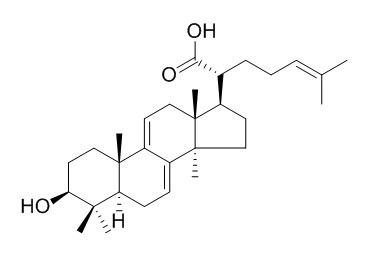Dehydrotrametenolic acid
Dehydrotrametenolic acid is a promising candidate for a new type of insulin-sensitizing drug; it can be a potential anticancer agent against H-ras transformed tumor.
Inquire / Order:
manager@chemfaces.com
Technical Inquiries:
service@chemfaces.com
Tel:
+86-27-84237783
Fax:
+86-27-84254680
Address:
1 Building, No. 83, CheCheng Rd., Wuhan Economic and Technological Development Zone, Wuhan, Hubei 430056, PRC
Providing storage is as stated on the product vial and the vial is kept tightly sealed, the product can be stored for up to
24 months(2-8C).
Wherever possible, you should prepare and use solutions on the same day. However, if you need to make up stock solutions in advance, we recommend that you store the solution as aliquots in tightly sealed vials at -20C. Generally, these will be useable for up to two weeks. Before use, and prior to opening the vial we recommend that you allow your product to equilibrate to room temperature for at least 1 hour.
Need more advice on solubility, usage and handling? Please email to: service@chemfaces.com
The packaging of the product may have turned upside down during transportation, resulting in the natural compounds adhering to the neck or cap of the vial. take the vial out of its packaging and gently shake to let the compounds fall to the bottom of the vial. for liquid products, centrifuge at 200-500 RPM to gather the liquid at the bottom of the vial. try to avoid loss or contamination during handling.
Universiti Tunku Aboul Rahman2023, 6263.
J Vet Sci.2020, 21(3):e39.
J Ginseng Res.2023, 47(4):572-582.
Nat Commun.2024, 15(1):8221.
Biochem Pharmacol. 2020, 177:114014.
Environ Toxicol.2023, 38(7):1641-1650.
Molecules.2021, 26(2):313.
Antioxidants (Basel).2020, 9(4):326.
Nutr Metab (Lond).2019, 16:31
Food Funct.2022, doi: 10.1039
Related and Featured Products
Life Sci. 2006 Jan 2;78(6):607-13.
Dehydrotrametenolic acid selectively inhibits the growth of H-ras transformed rat2 cells and induces apoptosis through caspase-3 pathway.[Pubmed:
16112686]
The screening of natural products that preferentially inhibit growth of H-ras transformed rat2 cells vs. rat2 cells was performed to identify H-ras specific growth inhibitor.
METHODS AND RESULTS:
A lanostane-type triterpene acid, Dehydrotrametenolic acid (3beta-hydroxylanosta-7,9(11),24-trien-21-oic acid), was isolated from the sclerotium of Poria cocos (Polyporaceae). Dehydrotrametenolic acid selectively inhibited the growth of H-ras transformed cells with a GI(50) value of 40 microM. FACS analysis indicated that the compound exerted its anti-proliferation effects through cell cycle arrest at G2/M phase and accumulation of sub-G1 population. Dehydrotrametenolic acid-induced apoptosis was further confirmed with chromosomal DNA fragmentation, caspase-3 activation, and degradation of PARP and Lamin A/C degradation. The compound also regulated the expression of H-ras, Akt and Erk, which are the downstream proteins of H-ras signaling pathways.
CONCLUSIONS:
The results suggest that Dehydrotrametenolic acid can be a potential anticancer agent against H-ras transformed tumor.
Biol Pharm Bull. 2002 Jan;25(1):81-6.
Dehydrotrametenolic acid induces preadipocyte differentiation and sensitizes animal models of noninsulin-dependent diabetes mellitus to insulin.[Pubmed:
11824563]
We recently discovered that the triterpene acid compound Dehydrotrametenolic acid promotes adipocyte differentiation in vitro and acts as an insulin sensitizer in vivo. This natural product has been isolated from dried sclerotia of Poria cocos WOLF (Polyporaceae), a well-known traditional Chinese medicinal plant.
METHODS AND RESULTS:
We examined the effects of Dehydrotrametenolic acid on plasma glucose concentration in obese hyperglycemic db/db mice. Dehydrotrametenolic acid can reduce hyperglycemia in mouse models of noninsulin-dependent diabetes mellitus (NIDDM) and act as an insulin sensitizer as indicated by the results of the glucose tolerance test. These terpenoids and thiazolidine type of antidiabetic agents such as Ciglitazone, although structurally unrelated, share many biological activities: both induce adipose conversion, activate peroxisome proliferator-activated receptor gamma (PPAR gamma) in vitro, and reduce hyperglycemia in animal models of NIDDM. Dehydrotrametenolic acid is a promising candidate for a new type of insulin-sensitizing drug.
CONCLUSIONS:
This finding is very important for the development of insulin sensitizers that are not of the thiazolidine type.



